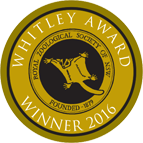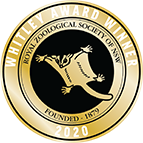Book Review
Neil Fraser
An Atlas of the Birds of NSW & the ACT, Volume 2. Comb-crested Jacana to Striated Pardalote
By Richard M Cooper, Ian A. W. McAllen, Christopher C. P. Brandis and Brian R. Curtis, 2016
New South Wales Bird Atlassers Inc, 674 pp., numerous tables, graphs and maps.
Hardback, A4 format, $135, ISBN 9780957704749
The New South Wales Bird Atlassers have published Volume 2 of The Atlas of NSW and ACT birds (Atlas), including those of the western Tasman Sea. The volume contains information on 165 resident and migratory species from Comb-crested Jacana to Striated Pardalote. For each species, there are maps, graphs and tables that summarize the reported distribution, breeding distribution, seasonal and historic range changes, together with monthly breeding records and monthly and annual reporting rates. The text provides a summary of what is known about the occurrence, distribution, breeding biology, movements, history and current status of each species.
A detailed description of the methodology and reporting techniques used to prepare the individual species accounts was included in a review of Volume 1 in Whistler, Volume 8, 2014. The same style and layout has been continued in Volume 2. The Atlas provides quantitative data of trends that will be invaluable in developing environmental policy, minimising future impacts and planning more cost effective research and conservation programmes. The long-term data set and analysis used to prepare the Atlas provides a baseline against which future changes and the effectiveness of conservation measures can be evaluated.
The Atlas will not be a reference source of first choice for the average bird enthusiast. It will appeal mainly to more technically minded ornithologists, conservation organisations, wildlife managers, environmental consultants, scientists and government agencies. However, I would encourage anyone who can access a copy to read the section on their favourite species. The majority of the information is not available in Field Guides or HANZAB and provides a clear understanding of the status of each species and where conservation efforts should be targeted.
Change in annual reporting rate is the prime quantitative tool used to illustrate the status of species and relies on the assumption that change in reporting rate can be used to infer change in abundance. It also relies on the assumption that survey effort is uniform. In some instances however, a bias in regional survey effort has influenced reporting rate trends and these are highlighted in the text.
At first glance the volume presents a depressing picture for the future of approximately one half of the species described. Around one quarter of the species are classified as threatened under the NSW Threatened Species Conservation Act 1995 and/or the federal Environment Protection and Biodiversity Conservation Act 1999. Most of the threatened species are characterised by significantly reduced distribution and rapidly declining annual reporting rates.
Another quarter of the species described that are not classified as threatened, also exhibit declining reporting rates, particularly since 1990. However, some of the declining reporting rate trends are an artefact of biased survey effort, while those species with large populations and widespread distribution are judged not to warrant concern at this time. Further, the decline in reporting rate for some species affected by prolonged drought, particularly those with ‘boom-bust’ life cycles, may only be a temporary effect. The Atlas provides a sound basis for making decisions to implement closer monitoring of any of these species in the future.
However, when the majority of resident species are considered as a whole there is an overarching pattern of consistent decline of small woodland species at the expense of larger, more mobile species that have adapted to anthropogenic change. Readers may be surprised to learn that reporting rates for all thornbill species, except Brown Thornbill are declining, as are those of both pardalote species. The trend is the same for Western Gerygone, Weebill, Southern Whiteface, Southern Emu-wren, and all the heathwrens and fieldwrens. There main factors producing this decline are undoubtedly clearing and fragmentation of habitat, drought, over-grazing and climate change.
The Atlas also highlights the success of some species that have increased their distribution and reporting rate. For example, the large cuckoo species (Pheasant Coucal, Eastern Koel, Channel-billed Cuckoo, Pallid Cuckoo) all exhibit increased reporting rates. This contrasts with the smaller cuckoo species (Shining Bronze-Cuckoo, Horsfield’s Bronze-Cuckoo, Fan-tailed Cuckoo) all of which have declining trends. This decline sadly, parallels that of those small woodland species that act as hosts.
The Swift Parrot, a Critically Endangered species with specialist foraging requirements is widely recorded across eastern NSW but reports are so varied as to not provide a definitive trend. In contrast, the iconic Superb Parrot, another threatened species with specialist foraging requirements, exhibits an increase in reporting rate.
Many migratory waders that are not classified as threatened exhibit a decrease in reporting rate in NSW and are a matter for concern. This includes Common Greenshank, Common Sandpiper, Little Curlew, Grey-tailed Tattler, Ruddy Turnstone and Whimbrel. This section of the Atlas highlights the ‘coastal centric’ view many of us take towards this group. Common Sandpiper, Marsh Sandpiper, Common Greenshank, Ruddy Turnstone are some of the migratory waders that are widely reported across the rivers and wetlands of inland NSW. While considerable focus is placed upon conserving coastal habitat, the Atlas highlights the need for conserving inland habitat as well.
Unfortunately, the data cut-off of 2006 predates the escalation of threat to many species that has occurred over the past decade, particularly in the Hunter Region. Significant migrator wader habitat loss has also occurred in East Asia over the past decade. More up to date data will be required to full assess the impact of these recent changes.
The NSW Bird Atlassers data set is the longest ongoing set collected with consistent methodology in NSW and users can have confidence that the observed trends are real. The extensive bibliography accompanying the text will be a major asset to future researchers. The authors of the volume and the thousands of bird surveyors who have contributed to its production over several decades are to be congratulated for their efforts.
Volume 3 is planned to be published in 2018 and will cover species from Eastern Spinebill to Common Greenfinch, as well as vagrant species and the birds of the Lord Howe group.
Neil Fraser









